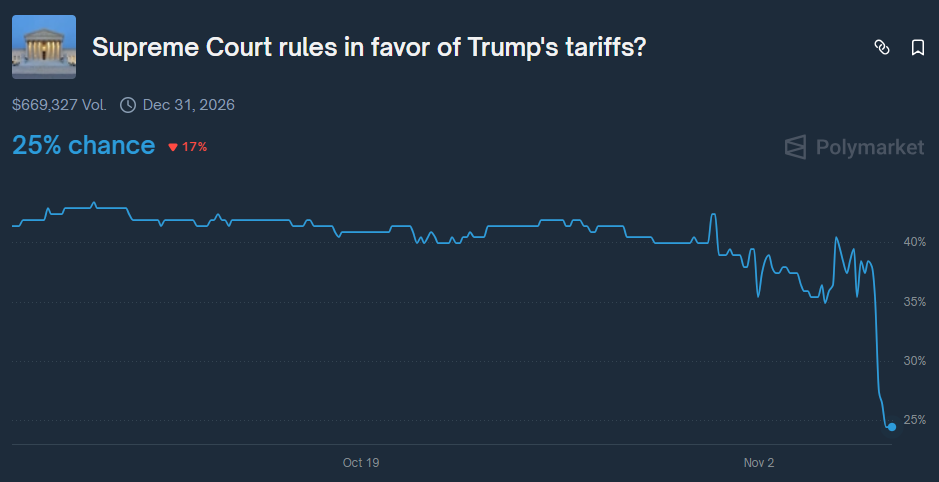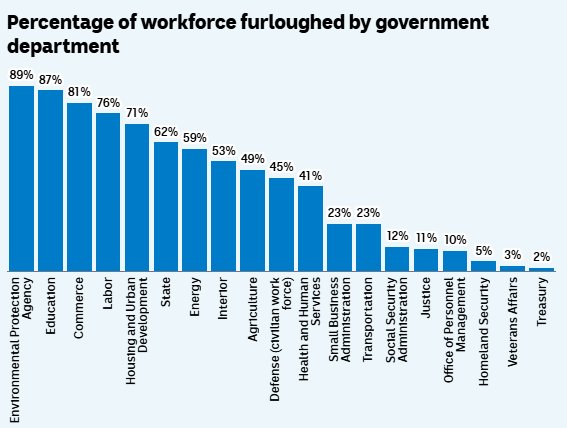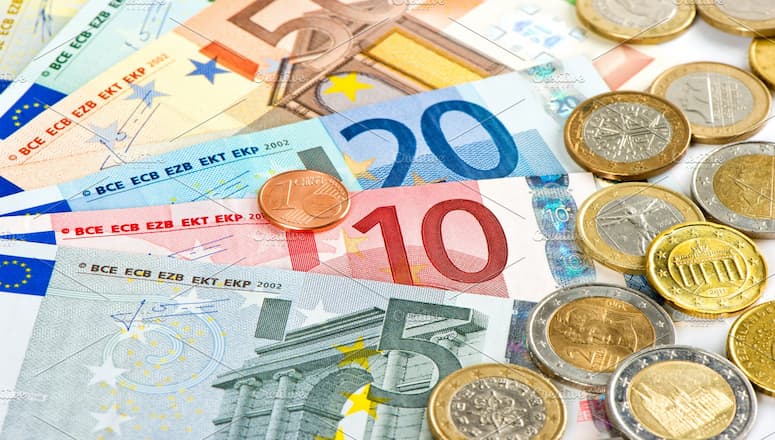Notícias de mercado & insights
Mantenha-se à frente dos mercados com insights de especialistas, notícias e análise técnica para orientar suas decisões de negociação.

Artificial intelligence stocks have begun to waver slightly, experiencing a selloff period in the first week of this month. The Nasdaq has fallen approximately 2%, wiping out around $500 billion in market value from top technology companies.

Palantir Technologies dropped nearly 8% despite beating Wall Street estimates and issuing strong guidance, highlighting growing investor concerns about stretched valuations in the AI sector.
Nvidia shares also fell roughly 4%, while the broader selloff extended to Asian markets, which experienced some of their sharpest declines since April.
Wall Street executives, including Morgan Stanley CEO Ted Pick and Goldman Sachs CEO David Solomon, warned of potential 10-20% drawdowns in equity markets over the coming year.
And Michael Burry, famous for predicting the 2008 housing crisis, recently revealed his $1.1 billion bet against both Nvidia and Palantir, further pushing the narrative that the AI rally may be overextended.
As we near 2026, the sentiment around AI is seemingly starting to shift, with investors beginning to seek evidence of tangible returns on the massive investments flowing into AI, rather than simply betting on future potential.
However, despite the recent turbulence, many are simply characterising this pullback as "healthy" profit-taking rather than a fundamental reassessment of AI's value.
Supreme Court Raises Doubts About Trump’s Tariffs
The US Supreme Court heard arguments overnight on the legality of President Donald Trump's "liberation day" tariffs, with judges from both sides of the political spectrum expressing scepticism about the presidential authority being claimed.
Trump has relied on a 1970s-era emergency law, the International Emergency Economic Powers Act (IEEPA), to impose sweeping tariffs on goods imported into the US.
At the centre of the case are two core questions: whether the IEEPA authorises these sweeping tariffs, and if so, whether Trump’s implementation is constitutional.
Chief Justice John Roberts and Justice Amy Coney Barrett indicated they may be inclined to strike down or curb the majority of the tariffs, while Justice Brett Kavanaugh questioned why no president before Trump had used this authority.
Prediction markets saw the probability of the court upholding the tariffs drop from 40% to 25% after the hearing.

The US government has collected $151 billion from customs duties in the second half of 2025 alone, a nearly 300% increase over the same period in 2024.
Should the court rule against the tariffs, potential refunds could reach approximately $100 billion.
The court has not indicated a date on which it will issue its final ruling, though the Trump administration has requested an expedited decision.
Shutdown Becomes Longest in US History
The US government shutdown entered its 36th day today, officially becoming the longest in history. It surpasses the previous 35-day record set during Trump's first term from December 2018 to January 2019.
The Senate has failed 14 times to advance spending legislation, falling short of the 60-vote supermajority by five votes in the most recent vote.
So far, approximately 670,000 federal employees have been furloughed, and 730,000 are currently working without pay. Over 1.3 million active-duty military personnel and 750,000 National Guard and reserve personnel are also working unpaid.

SNAP food stamp benefits ran out of funding on November 1 — something 42 million Americans rely on weekly. However, the Trump administration has committed to partial payments to subsidise the benefits, though delivery could take several weeks.
Flight disruptions have affected 3.2 million passengers, with staffing shortages hitting more than half of the nation's 30 major airports. Nearly 80% of New York's air traffic controllers are absent.
From a market perspective, each week of shutdown reduces GDP by approximately 0.1%. The Congressional Budget Office estimates the total cost of the shutdown will be between $7 billion and $14 billion, with the higher figure assuming an eight-week duration.
Consumer spending could drop by $30 billion if the eight-week duration is reached, according to White House economists, with potential GDP impacts of up to 2 percentage points total.


The ASX200 has seen some positive price action in recent weeks as the Australian equities market has benefited from relatively weaker inflation then much of the rest of the world. With the Reserve Bank of Australia, (RBA) only increasing interest rates by 25 bps at each of its last two meeting, the country’s central bank has seemingly chosen that inflation is perhaps the lessor of two evils against the potential of a recession. On the other hand, with expected inflation to increase to 8%, the RBA may be hoping for a softer landing and slower move to control inflation.
In response to the two most recent cash rate changes, the ASX200 has been the beneficiary with the index testing its two-month high. On the weekly chart, the index has so far bounced off its long-term support zone and its 200-week moving average. This may indicate that the index has ‘bottomed’ at least in the short term.
The price is also showing signs of a potential double bottom reversal pattern, with the two bottoms being at approximately 6500 points. If the price can break through the neckline and confirm itself as a double bottom it may accelerate through and test the all-time high resistance at 7617. On the daily chart the index shows some further encouraging signs of a reversal or breakout.
The index has broken out of the down channel in the last two days and has reclaimed both the 50 day and 200 day moving averages. In addition, the 50-day moving average is beginning to kick up, which indicates some short-term bullish sentiment. It is important to remember that there may still be some headwinds with inflation and recessionary pressures still dictating much of the short-term price action, pushing higher may not be an easy feat.


The EUR has been rebounding strongly on the back of being sold off for much of the year. With inflation at record highs and a cost of living and energy crisis, the currency has become extremely weak, even dropping below parity with the USD. However, in recent week, the EUR has begun putting in a bottom.
The ECB last night decided to raise their official rate by 75 bps. which along with a dovish statement caused a sharp drop in the EUR. On the weekly chart, the price has largely been in long term range with some exceptions relating to large economic events. Although, the price has been known to spike at various stages of economic volatility.
The chart shows that the price has been quite choppy between the range of 1.4000- 1.8500. The daily chart shows a potential double bottom that has been forming. The two bottoms are near 1.5700 and the neckline at approximately 1.7000.
The price already broke through the neckline and is nearly ready to retest the area as support. If the price can bounce off the neckline, it may have a primary target at 1.80, and then a secondary target of 1.8500. Waiting for ether a strong rejection candle or a consolidation near the neckline may provide a significant risk reward of near 3.5 or higher.
With inflation data the ECB still providing important information there may be some headwinds for the EUR as the region continues to deal with inflation.


Stop loss hunting is frustrating, annoying and can be detrimental to any retail trader. The premise of stop hunting is that large systemised institutional trading strategies know where the average retail trader or most traders will set stop losses and therefore profit off triggering these ‘stops. Their own algorithm will then deliberately, trigger the stop losses.
For traders there are few things as frustrating as have a well-positioned trade, being stopped out and then watching the price reverse in their original direction of the trade. What is a stop loss? Understanding stop loss hunting requires a simple understanding of what a stop loss is.
A stop loss is a trigger on traders’ position to close the position at a certain price. Generally, once triggered the position will attempt to be closed at the specified price. Stop losses provide an important role in risk management for many traders.
Generally, traders use stops losses to avoid emotional mismanagement and better manage overall risk by having clear exit points for the trade in worst case scenarios. The second element that is important to understand is where traders put their stop losses and why. Retail traders often place their stop losses near important market structures also known as support and resistance levels.
These areas represent strong zones of supply and demand. When support and resistance zones become more and more consistent and more obvious, it can create a clump of stop losses. These stop losses can be thought of as orders that must get filled if the price reaches those points.
This creates an attractive opportunity for large institutions with powerful algorithms that can push the price down and generate profits by ‘stopping out’ traders by triggering these stop losses. Once this process has occurred, the price will often move back in the direction the original trades were positioned for. Why would a system want to trigger stop losses Firstly, when stop losses are triggered, a price tends to see an increase in relative volatility.
Therefore, it may indicate the beginning of a reversal which sophisticated traders profiting. It also allows these large institutions to maximise their own existing trades as it may allow for better entries. Common areas for where stop hunters will look Stop Loss hunting tends to be most active around significant and clear areas of support and resistance.
This is especially true with regards to commonly traded assets. However, stop loss hunting can occur in all assets with various sizes. A stop hunt can be seen often with a small candlestick and a large wick.
In addition, they often occur on very short time frames. Common Area for Stop Loss Hunting At key moving average levels Clear Support and Resistance Levels Historical Support and Resistance Levels ie, Multiyear levels How to deal with Stop Loss Hunting? The obvious tactic to deal with stop hunting is to lower the stop loss below the obvious support and resistance level by a factor of maybe 10%.
This may require smaller trade size, but overall will allow the trade to hopefully avoid these potential stop losses. Treat support and resistance as areas instead of specific price points. Support and resistance do not exist at one price and rather a range of prices that are supply and demand zones.
Therefore, placing stop losses below these 'zones' may put the trade out of arm length of stop hunters. Simply being aware of stop loss hunting may provide some reassurance when a sharp spike in price occurs, to remain in the trade and not exit immediately. Ultimately, Stop Loss Hunting is just another challenge that traders must deal with in the pursuit of profit.
However, with some knowledge traders can adequately accommodate these tricky occurrences.


The EURUSD is showing some signs of a potential short term break out on the daily and 4-hour time price charts. This is largely a technical breakout, although it is also supported by a shift in sentiment towards growth assets and away from the USD in the last week. Technical Analysis The daily cart shows a long term down trend with the price respecting the trend.
On the daily time frame, the price has broken through the trend line. In addition, the price has broken above the 50 period Exponential Moving Average. This represents a short-term support level and a good position for a trailing stop loss or hard stop loss.
Looking at the 4-hour chart provides a more direct profit target and entry trigger. The chart shows that the candle sticks are forming into what may become a flag. An entry based on the current price action may be triggered by a breakout of the flag past 1.000 which is also the parity level.
This level also presents as the neckline for a double bottom. This further indicates a potential bottom, or a reversal is about to take place. Using the 50-day Exponential moving average as the position for the stop loss at 0.9914, and the next resistance as a profit target at 1.0200 gives the trade yields a Risk Reward ratio of nearly 2.7.
With volatility surrounding the market being relatively high there is still risks with this trade and traders should be aware of potential macro factors that may impact on the trade.


The UK has had to deal with recessionary fears, sky high energy prices, a cost-of-living crisis, and a breakdown in political leadership. This has caused the GBP to fall to lows not seen since the last century. The British economy has also had to deal with a potential liquidity crisis caused by some of the large UK retirement funds almost bringing down the UK economy however with some support from the Bank of England the situation has in the short term been resolved.
The political pressures have also eased somewhat with Liz Truss stepping down and Rishi Sunak taking over the role of Prime Minister, which may further support the potential for a reversal and show o strength in the pound. With the price so beaten down at some stage it will have to turn around. The question is this reversal about to occur?
Technical Analysis On the weekly chart, the price has been ranging between 1.4369 and 1.1985. Earlier this year the price dropped below the bottom of the range for second time with the only other time being the initial stages of the pandemic. The lower bounds of the range present a potential target if the reversal is validated.
The price has finally started higher and the strength of the weekly candles and the volume supporting the price action indicates that supply is being depleted. The risk for a potential reversal is just how aggressive the long-term moving averages are to the sell side. Both the 50- and 200-week moving averages are still pushing to the downside.
The daily chart shows an interesting picture. The price of the pair is clearly coiling and almost ready to break out of its consolidation. If the price can break out it may provide a short-term target of 1.19853 may provide a potential price to take profit.
With volatility seemingly settling around the UK's economy, the potential for a reversal remains, which may only improve the prospects for the Pound.


Coca-Cola tops Wall Street Q3 estimates The Coca-Cola Company (NYSE:KO) reported Q3 financial results before the market open on Tuesday. The US beverage company posted solid results for the quarter, beating Wall Street analyst estimates for both revenue and earnings per share (EPS). Revenue reported at $11.063 billion (up by 10% year-over-year) vs. $10.52 billion expected.
EPS at $0.69 per share (up by 7% year-over-year) vs. $0.637 per share estimate. ''Our strong capabilities and consumer insights continue to help us win in the marketplace,'' Coca-Cola CEO, James Quincey said in a press release. ''Our business is resilient amidst a dynamic operating and macroeconomic environment. We are investing in our strong portfolio of brands, which is a cornerstone of our ability to deliver long-term value for our stakeholders,'' Quincey added. Shares of Coca-Cola were up by around 1% on Tuesday, trading at $58.49 a share.
Stock performance 1 month: +3.39% 3 months: -7.78% Year-to-date: -1.55% 1 year: +7.01% Coca-Cola price targets Deutsche Bank: $59 Wedbush: $63 Morgan Stanley: $68 Credit Suisse: $64 Wells Fargo: $66 HSBC: $76 UBS: $72 JP Morgan: $70 Coca-Cola is the 30 th largest company in the world with a market cap of $251.88 billion. You can trade The Coca-Cola Company (NYSE:KO) and many other stocks from the NYSE, NASDAQ, HKEX, ASX, LSE and DE with GO Markets as a Share CFD. Sources: The Coca-Cola Company, TradingView, MetaTrader 5, Benzinga, CompaniesMarketCap

